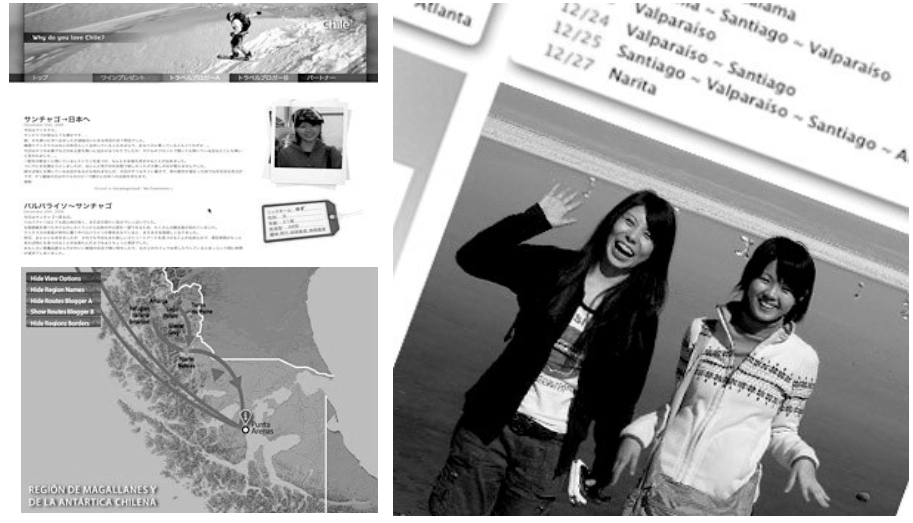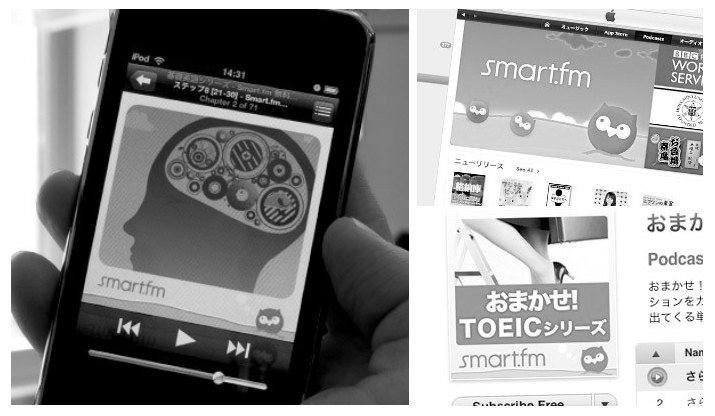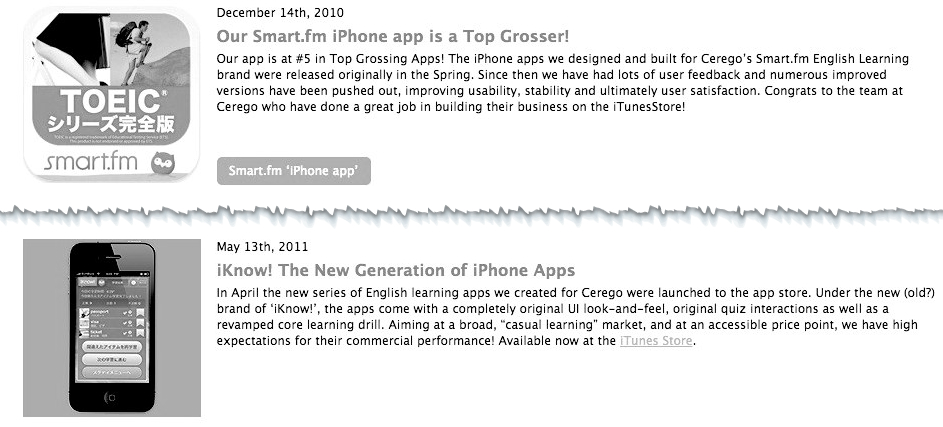This is the 6th post in my “Becoming a creative hybrid” series recounting my experiences building and ultimately selling a digital agency in Tokyo. This post covers the arrival of the iPhone and later Android smartphones, roughly between 2008~2011.
Previous memoir episodes series have described how we cracked the code for making content-based promotions in Japan (as with the Puchi Bruce campaign for Die Hard 4.0 explained here), or how we got a taste for building technology solutions (as with the iTunes blogparts explained here). But no account of this period in the late noughties would be complete without documenting the disruptive rise (and rise…. and rise…) of the iPhone, and thence the smart phone, and it certainly had a big impact on the Alien-Eye business too. Zooming forward to 2014 as I write now as Lowe Profero I am sure that more than half of what we output is experienced on a smartphone.
It is hard to believe now with the recent launch of the 5.5inch iPhone 6 that the first iPhone was basically an iPod with telephony. Through our involvement with iTunes we were very much aware of the significance of Apple’s ecosystem of digital content across devices being extended to mobile phones, but we could not have imagined just how disruptive the App Store would be, creating an open market place for software.
As described in Chapter #1, when we set out on the Alien-Eye journey we expected the Japanese mobile carriers to enable an open mobile contents ecosystem, but this was in hindsight very naive of us. So although the bedroom creators and hackers got busy making Flash movies and games that could be freely distributed on the web, they did not have a platform geared to surface and popularise the most creative and original to a wide audience, and mobile content distribution was closed / locked down completely by the close-minded carriers. There certainly was no platform with the allure of coding for a new domain of interaction – the touch screen, combined with accelerometers, GPS and cameras all in one app.
YouTube proved to be that creators’ platform for video, complemented here by the distinctively Japanese video platform NicoNico, but no one could have predicted the phenomenon that was the gold rush onto the App Store, although I am sure some claim they did. All of a sudden designers and videographers, university students and ICT teachers alike were learning to code in C+. We certainly did not miss out either, and the constant stream of mobile app development projects, firstly for iOS, and then for iOS & Android, helped grow and sustain our in-house development team through to late 2011, when as previously lamented on this blog, we admitted defeat on a coding team without scale.
The first iPhones in Japan
Our first iPhone app project happened astride New Year 2007 > 2008, which was even before the first iPhone’s came on sale in Japan in July 2008, and was the first iPhone-related campaign of any kind to my knowledge. We were so desperate to get in on the act that we had someone bring us 3 iPhone’s from Hong Kong that we developed and tested on before promptly handing them to the winners of a travel blogger competition we ran to promote Chile as a tourist destination.
Applicants had to reply to the question “Why I want to go to Chile”, and having been seeded skillfully into young adventurous travel communities in Mixi this contest generated over ten thousand inspiring reasons to do just that, all in the persuasive and credible words of real people, creating a viral mechanism around the campaign. The winning trio were then sent to Chile, armed with an iPhone each and a suite of GPS-aware apps we hacked together to live blog their way around Chile’s stunning locations with instructions to take loads of pictures, and micro-blog about all the fun they were having. These posts were uploaded directly to open community platforms like Twitter as well as auto-aggregated into a live-stream campaign site that we set up.

Chile Tourism Campaign that was made possible by live blogging from GPS enabled apps on an early iPhone
All of this content, as well as the social media buzz, combined with the blog and travel news site coverage of the contest successfully transformed Chile’s online presence and positioning as a destination for young independent travellers. One of the most satisfying aspects of this project was that it fixed Chile’s SEO problem in Japanese. Until that point a search for Chile would yield pages of results relating to either ‘ebi-chili’ recipes, the popular chinese spicy prawn dish, or else the Red Hot Chili Peppers, since both contain the same two katakana characters “CHI-RI” as the country, and are searched for more frequently. Finally, and thanks in some ways to the iPhone, Chile was visible on the web in the Japanese language.
Today the Japanese app store is the most lucrative in the World, for the first time topping the US’s app store revenue in 2013, and now with Android going strong too, sales of game titles on smartphones are fuelling multi-billion-$ game companies’ IPOs and really killing consul makers like Nintendo with it. But back in 2009 when the iPhone sales had just about given the platform enough scale for businesses to take a serious look at it, things were more open and explorative.
Before there were apps, there were….
Our most complete experience with the App store came through a partnership with Tokyo-founded Cerego Inc, and their English learning platform iKnow!, previously named Smart.fm, but because we had already been active on another Apple-popularised platform, podcasting, we were able to adapt our way into apps in effect.
Over 4 or 5 years of working with Cerego I personally enjoyed numerous close working relationships through which I learned an awful lot, and several of those live on as cherished friendships, but it was co-founder Andrew Smith Lewis who brought us in initially and, with his eye for seeing a chance to create eye-catching spin-offs that made the core platform more convivial with the big wide web outside, was an essential supporter and advisor to all the projects we worked on together.
The partnership with Cerego had flourished during 2008 & 2009 thanks mainly due to the amazing success of a podcast program that notched up 10m downloads in its first 2 months after launch and was featured as top podcast in iTunes Japan’s “Rewind 2009” ranking.
The brain child of a talented and passionate Italian multi-media designer, Francesco Romano, he first conceived of the idea of creating podcasts that streamed the multi-media vocab flashcards as a smooth audio-visual experience while he was still working at Cerego. But the company’s focus was elsewhere and so they never got made. Some time later, and for various reasons everyone agreed, including Francesco himself, that he would be better off in the more diverse cut and thrust of the Alien-Eye working culture, and so we got to nurture his podcast idea among many other of his inspired creations.

Enhanced podcast format that used chapter images to create a simple interactive English learning flow c. 2009
Francesco’s podcast hack relied on using the chapters feature in the podcast format, fitting one vocab item plus its accompanying image for each chapter, with audio files playing the audio file for the word, another chapter was used for an example sentence with its audio and image. We could control how many such items we stringed together to make up one podcast. These were interactive to the extent that users could skip between chapter points, although it seemed that most played them hands free on the train commuting.
But how to publish these efficiently? Another invention hooked the old and more hackable version of Garageband, amongst other things a podcast publishing software, to suck in the learning content data from Cerego’s databases and spit out beautifully designed audio-visual podcast.
In this way, Francesco, together with one of Cerego’s own prolific developers, Zev Blut, could generate hours of valuable learning media at will. This “enhanced podcast” format was a game changer on the podcast rankings, since all of the competing pods had to be made in recording studios with costly voice talent and audio engineers. We could produce high quality content much faster and cheaper than anyone else, so we were able to absolutely dominate the rankings. At one point we had 3 separate series created in this way occupying positions 1, 3 and 5 on the all Japan chart, and occupied #1 for most of one year.
To me this is a great example of a “growth hack”, a topic I have spoken and written a lot about in the years since, e.g. this post about growth hacking talent, and Francesco’s approach to turning his vision into reality by thinking fluidly and adaptively across technology platforms illustrates the required mindset.
The app store comes of age
So the first generation of the Smart.fm iPhone apps were based on the enhanced podcasts, but also included games and other interactive features that were developed and improved in later versions. Cerego entrusted us with creating and running this nascent off-shoot of their business, overseeing it of course, but allowing us to design everything, from the product itself, the naming, pricing strategy, promotional activity. We hired an app developer over from the US, Brett Gneiting, who we tracked down after he had been a prizewinner in Cerego’s API competition a year or so previously and he and Francesco formed an awesome UI/UX > coding partnership.
We really embraced this opportunity to take ownership for the performance of a business vertical, and the longevity of the partnership speaks to its financial success, riding the wave of popularity of each iPhone release and all the attention the App Store garnered, bringing in significant revenue for Cerego and keeping us honest too.
One of the most rewarding aspects of having ours hands on every element of the product and marketing strategy was the ability to apply strategic ideas and see very quickly and directly whether they worked or not. When you work on big brands in an agency with a bunch of smart, opinionated marketers you always look at the strategy and think you could write the script better: the client got the naming wrong, or screwed up the pricing strategy, or did not position it in the opportune way; but usually you are not able to change those core elements, and even if you could it would take a relative age to see the effects.
So the app store was almost like a microcosmic market simulator with very rapid and dynamic feedback, so we could tune all those things together with the smart folks at Cerego, Andrew Smith Lewis and Russ Moench in particular, and work out what worked best. In fact it was such an intensely industrious period and we cut our teeth in so many different ways that it spawned a host of different skill sets that we were able to offer to other clients, from short snappy promo videos like these for the first app series, we developed a whole app / web service identity design and positioning strategy offering off the back of this period, and over all it gave us a lot more confidence in our convictions as marketing strategists.
Cerego has developed an extensive and high quality corpus of learning material, and that is what we leveraged for the iPhone and later Android apps. But its secret sauce is when this content gets hooked up to its proprietary learning engine algorithm. For various reasons this could not be encoded into a standalone app, but once Cerego re-booted it’s backend for the cloud era and rebranded as iKnow! made their push as a truly web 2.0 service they were able to provide a seamless experience for their growing paid user base across all devices, and it made sense to phase out the stand-alones. However, the success of the app store partnership set up perhaps an even more empowering collaboration with Cerego that will be the subject of a future memoirs post I suspect.
Over the 2 or 3 years between 2009 and 2011 all kinds of brands were commissioning apps from us, IBM being another noteworthy one, and other agencies too of course. Although I am proud of much of the work we did, most of these programs became forgettable for one of two reasons.
The first was under investment in initial promotion versus development. There would be an intent to make the initial functionality as awesome as possible, leaving little of the inevitably limited budget to launch it properly. It would have been better to get to minimum viability quickly and cheaply and then test the water, but few brands are setup to think in this way.
The second was lack of sustained intent and investment. Like puppies, an app is for life, not just for christmas. Actually, an app is an investment in an engaged user group or audience, and you need to keep improving and developing your app in order to nurture and grown that user group. Marketing departments are sadly not usually empowered or else of a mind to embrace this sort of opportunity.
Since the gold rush era the “I want an app too” effect has warn off, we (now speaking as Lowe Profero) are still developing apps, but they are typically business critical ones, and we have several hundred top class developers to code them. Examples would be a members app for the multi-billion Euro fashion EC businesses like ASOS; the order for app Dominoes Pizza; the loyalty app for booming restaurant franchises like Guzman y Gomez…
The truly cloud-based service models like Cerego, whose team’s live and breath features, UI and UX across all platforms because they are the difference between business success and failure, have in general brought the development in house as you would expect, and so after 2012 we helped them in other ways.
And the app store itself is not the playground of tinkerers and hobbyists that it was in the early days when a developer in her bedroom could create and market an app and earn a million bucks in a month due to the inherent scaleability in and buzz around the marketplace. Some of those early entrepreneurs now run scaled up business around the app store, but most of them have been squeezed out, no longer able to get any visibility as big software and gaming companies have weighed in.
Actually the reasons for the minnows getting squeezed are probably as much to do with the ever increasing number of devices and iOS versions that apps needed to support, and that only got worse when Android swept into Japan. Towards the end of our partnership with Cerego on the app store in late 2011 we really felt this. In the early days of the App Store there were only a few handsets (iPods, iPhone, iPhone 2) and similarly few iOS versions. As Apple released each new wave of iPhones with bigger screens and new iOS versions with new capabilities the development resource required to keep up swelled.
This evolution suited Apple and the Android device makers just fine, since it put more pressure on users to upgrade to the latest model phones, (where most of the revenue is for Apple) and big gaming titles on the App and Play store dominate revenue anyway. So the gold rush with its long tail of entrepreneurs panning for gold came to pass on the big revenue-mining companies moved in. Such is the way of the world, and with its passing Apple too became less of a darling of the creative community, which loved the openness of the early app store. Steve Jobs passed away in October 2011 accompanied by much grief and sadness among us as well as so many others. Perhaps that was the date that marked the end of this chapter for us too.



Leave a comment